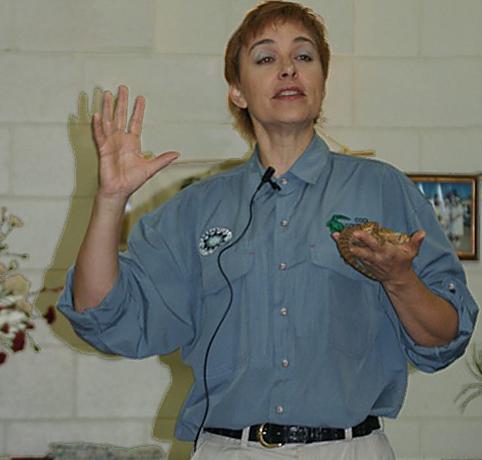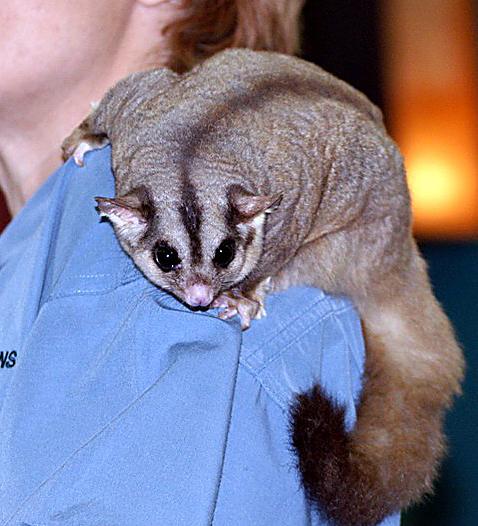Speaker Tania Carter - Cool Companions
/The lesson from the talks of Tania Carter is that, as gardeners, it is our duty to plant native plants to provide habitat and food for our unique wildlife.
Tania Carter gave a fascinating talk about our local native animals. Tania brought a number of her "Cool Companions" with her and gave members the opportunity for a hands on experience.
Tania Carter talked about how to encourage these creatures into our backyards.
Tania Carter began with the bearded dragon. These reptiles are good for gardens as they love to eat insects and grubs. If you pick a dragon up it will stiffen and fill up with air as a defense. The balance of lizards in our gardens has changed. Originally the frilled necks were common, but with development, they died out, probably due to the fact that they are easily stressed.
 As a result, the bearded dragons became dominant but now it is the larger water dragons, who adapt better and eat a greater variety of food than the bearded dragons.
As a result, the bearded dragons became dominant but now it is the larger water dragons, who adapt better and eat a greater variety of food than the bearded dragons.
The bearded dragons lay eggs, and while gardening they may be dug up. If this happens put them back in the same spot. If possible, try not to turn the eggs or the embryo, which is fixed to one point of the shell, may drown.
Next Tania Carter showed the blue tongued lizard, a member of the skink family. Blue tongues are often mistaken for snakes. One way to check if it is a snake or lizard, is that lizards have ears, whereas snakes don't.
Blue tongues are great snail and slug killers and have adapted well to living with people. They will often live in pipes. However, they are at risk of being killed by cats or dogs. If bird wire is placed over rockeries, the lizards can be provided with a safe refuge from these predators. Blue tongues give birth to live babies.
Blue tounges will stick their toungues out and hiss as a defense. Just push them away with a broom. If they happen to bite and won't let go simply put them on the ground and they usually let go. Blue tongues love bananas, strawberries and dog food.
It is not a good idea to relocate lizards as they often are attacked and die before they are able to learn where to find food, shelter etc.
Tania's next companion was the legless lizard which is often mistaken for a snake. Most of its body is its tail, so if it is grabbed and throws its tail it will take a long time for it to regrow. Legless lizards love to eat spiders.
Tania Carter next passed around the Keel Backed snake. This snake eats small toads and tadpoles. It is a non-poisonous harmless nocturnal snake and very useful to have around.
 Tania spent time talking about snakes. Snakes get frightened, will take off or defend themselves if cornered or attacked. The Eastern Brown is a highly strung dangerous snake that will readily defend itself. When about to attack it rises in an S shape. Safest thing to do is to leave it alone. The Red Bellied Black snake is a non aggessive snake and has an unjustified reputation for killing people. Many bites are caused by people trying to kill snakes, who of course, are defending themselves. People believe that all brown snakes are deadly, but many harmless or non aggressive snakes are also brown.
Tania spent time talking about snakes. Snakes get frightened, will take off or defend themselves if cornered or attacked. The Eastern Brown is a highly strung dangerous snake that will readily defend itself. When about to attack it rises in an S shape. Safest thing to do is to leave it alone. The Red Bellied Black snake is a non aggessive snake and has an unjustified reputation for killing people. Many bites are caused by people trying to kill snakes, who of course, are defending themselves. People believe that all brown snakes are deadly, but many harmless or non aggressive snakes are also brown.
A Children's Python was the next reptile. Tania said that about 80% of roofs in Brisbane have a resident carpet snake. These come in a variety of patterns and colours. Carpet snakes, like all reptiles need to warm themselves in the sun. When a carpet python lays eggs, it coils itself around the eggs to keep them warm. If the eggs get cold, the python shivers to warm them up. Carpet snakes eat rats, mice, possums and bats. When little they usually eat other reptiles, but as they grow they eat more warm blooded animals.
The next very cool companion who was greeted with lots of oohs and aahs was Lucy the bettong. Lucy is a Rufus Bettong. They are small members of the kangaroo family. They require a large area of habitat and are very shy. They eat roots and spend their nights digging. As they take a small amount of root of a number of different plants, they don't usually kill the plant. However, if forced into a small area of habitat, they may end up killing their food source. Tania emphasised the importance of providing habitat corridors. The Rufus Bettong is not endangered, but the Northern Bettong from Northern Queensland only eats fungus and as its habitat is cleared it is becoming endangered.
Most species in Australia are lost to land clearing rather than feral animals.
 Tania discussed how to remove babies from dead marsupials. It is important when finding a dead marsupial with a baby in its pouch, not to pull the baby from the teat. This can actually pull away the baby's mouth. Either take baby and mum to the vet or sanctuary or cut the teat off.
Tania discussed how to remove babies from dead marsupials. It is important when finding a dead marsupial with a baby in its pouch, not to pull the baby from the teat. This can actually pull away the baby's mouth. Either take baby and mum to the vet or sanctuary or cut the teat off.
The squirrel glider was next. This glider and the smaller sugar glider are at great risk from predatory animals such as cats and dogs. They also compete with other animals e.g. possums for holes in trees. They are becoming endangered and urgently need trees and corridors to survive. The gliders like to eat insects and fruit and they have a role in pollinating some species. They love to eat sap also and signs that they may be on our land are lumps of sap on the tree trunks. These gliders usually give birth to twins. Nest boxes for squirrel gliders can be bought. The entrance faces towards the tree for protection. Unfortunately, gliders are also the favourite food of owls.
 Tawny Frogmouths are actually not owls, but night jars. They lay eggs in the forks of trees and often their chicks end up on the ground. These birds like lots of insects and catch moths in the air. They have excellent camouflage and are hard to sea against the bark of trees.
Tawny Frogmouths are actually not owls, but night jars. They lay eggs in the forks of trees and often their chicks end up on the ground. These birds like lots of insects and catch moths in the air. They have excellent camouflage and are hard to sea against the bark of trees.
The last guest was a monitor lizard. Monitors are large lizards. They lay their eggs in termite mounds, leave them to incubate and then comes back to open up the mound when the babies are due to hatch. Monitors have very sharp teeth.
Article published by Karana Downs Garden Club Inc.


